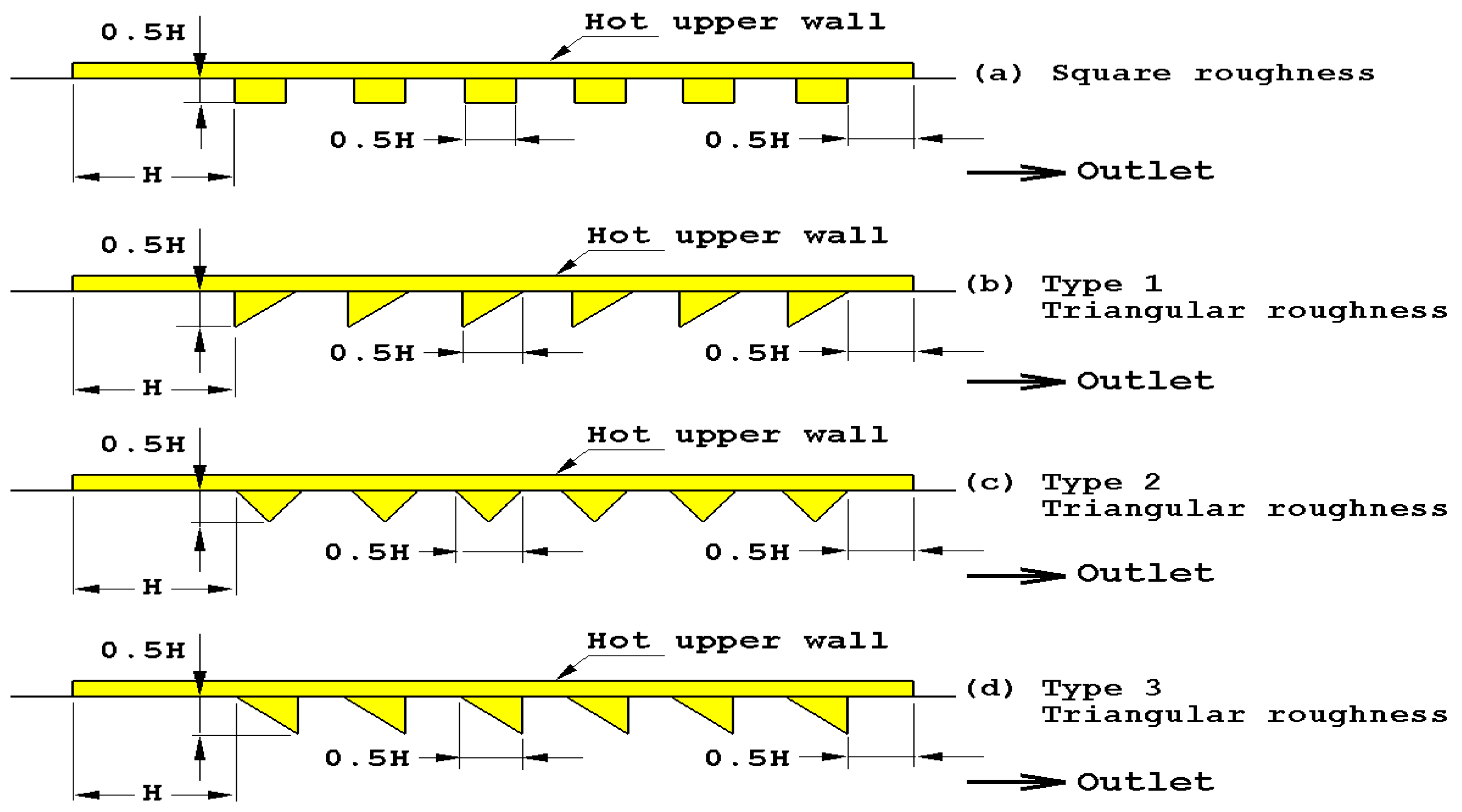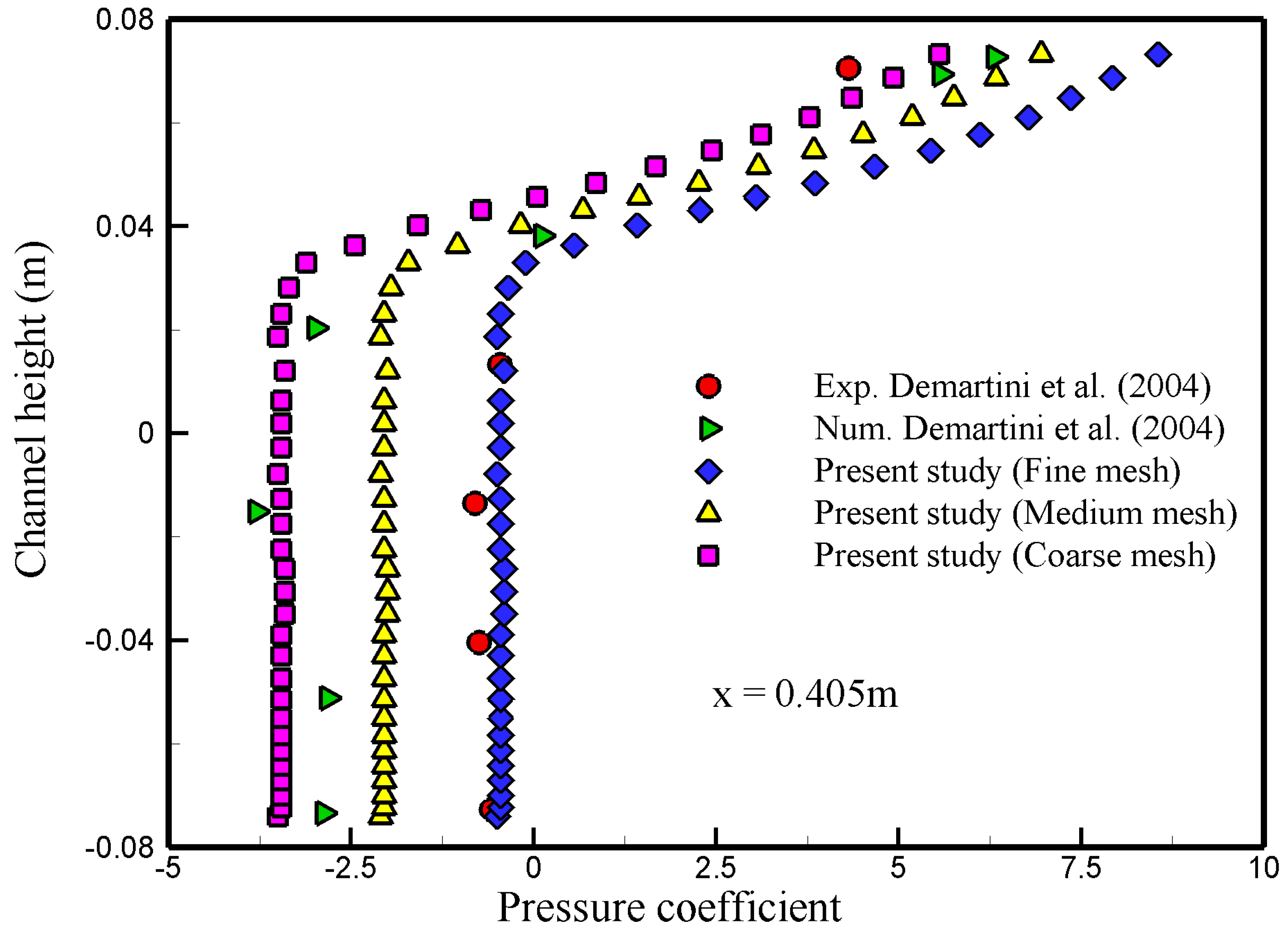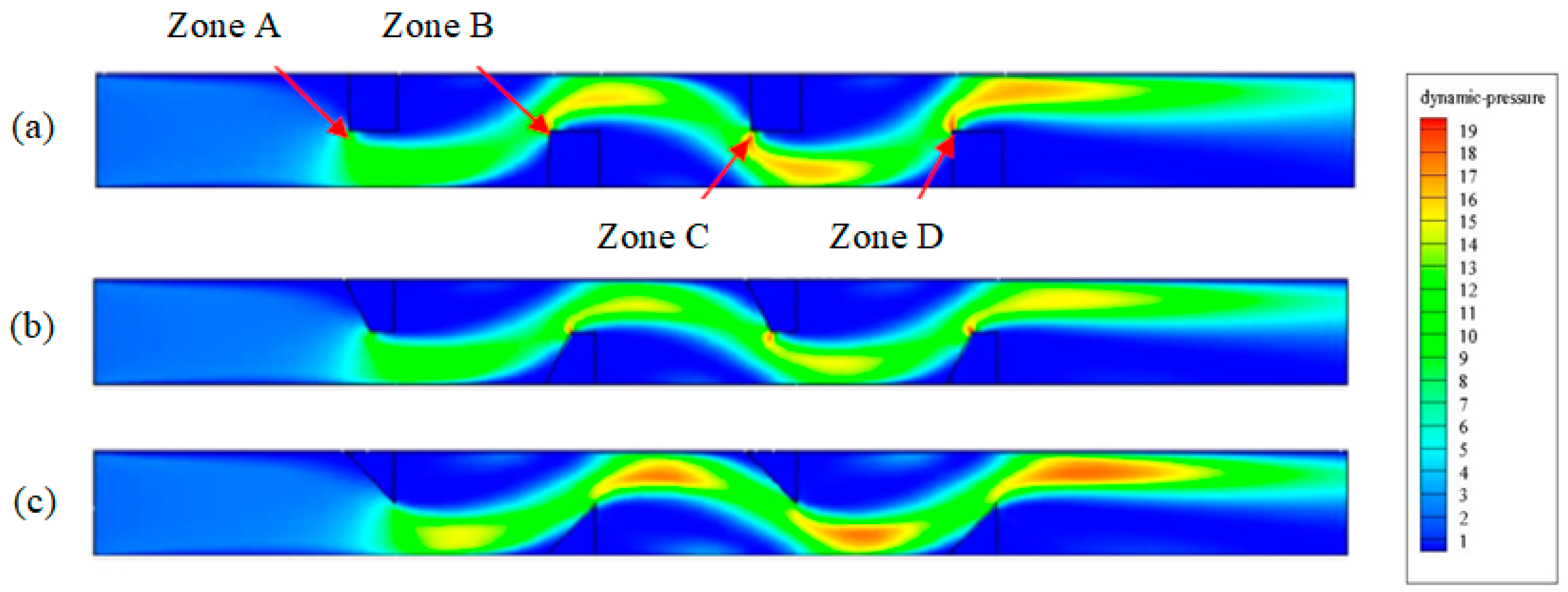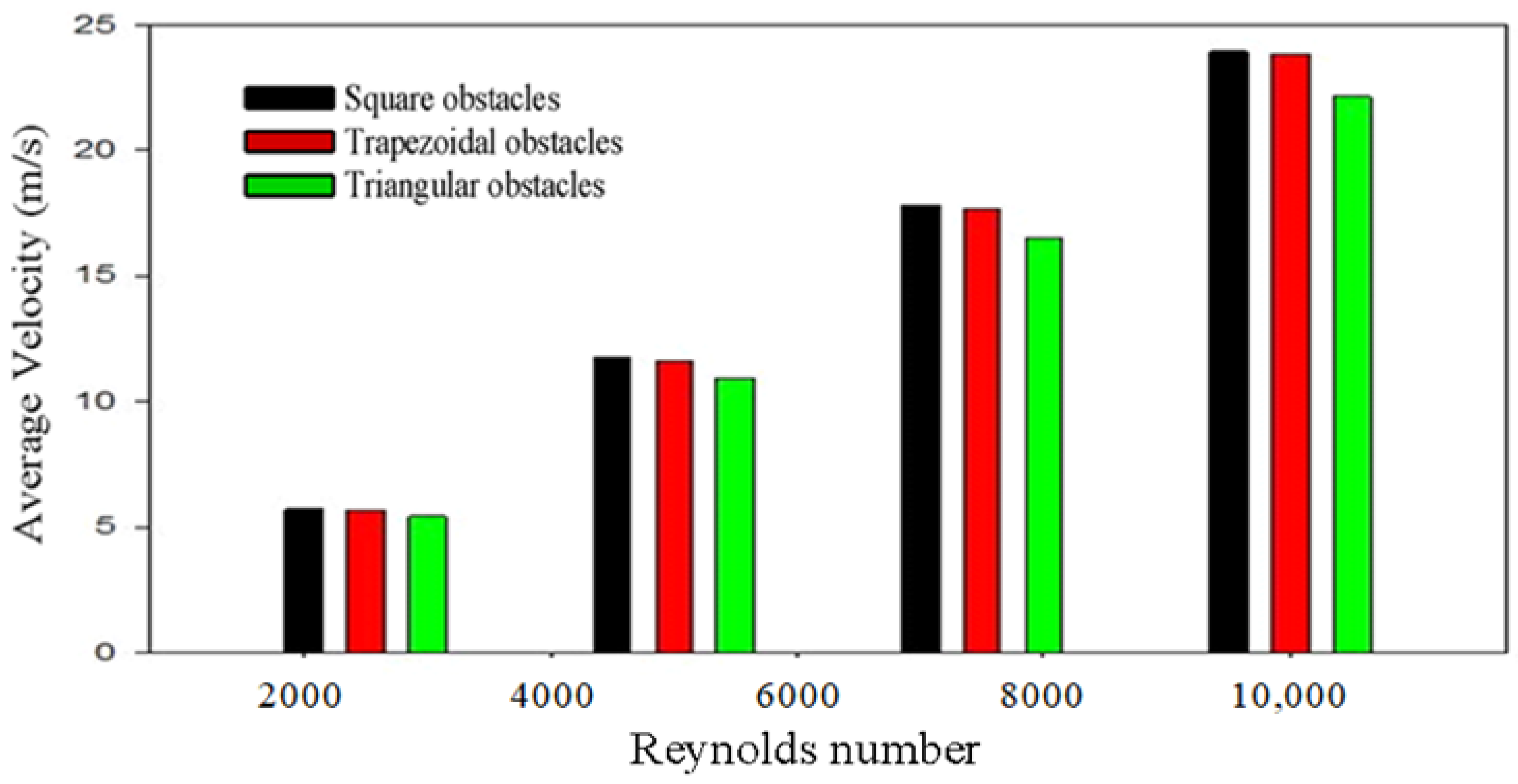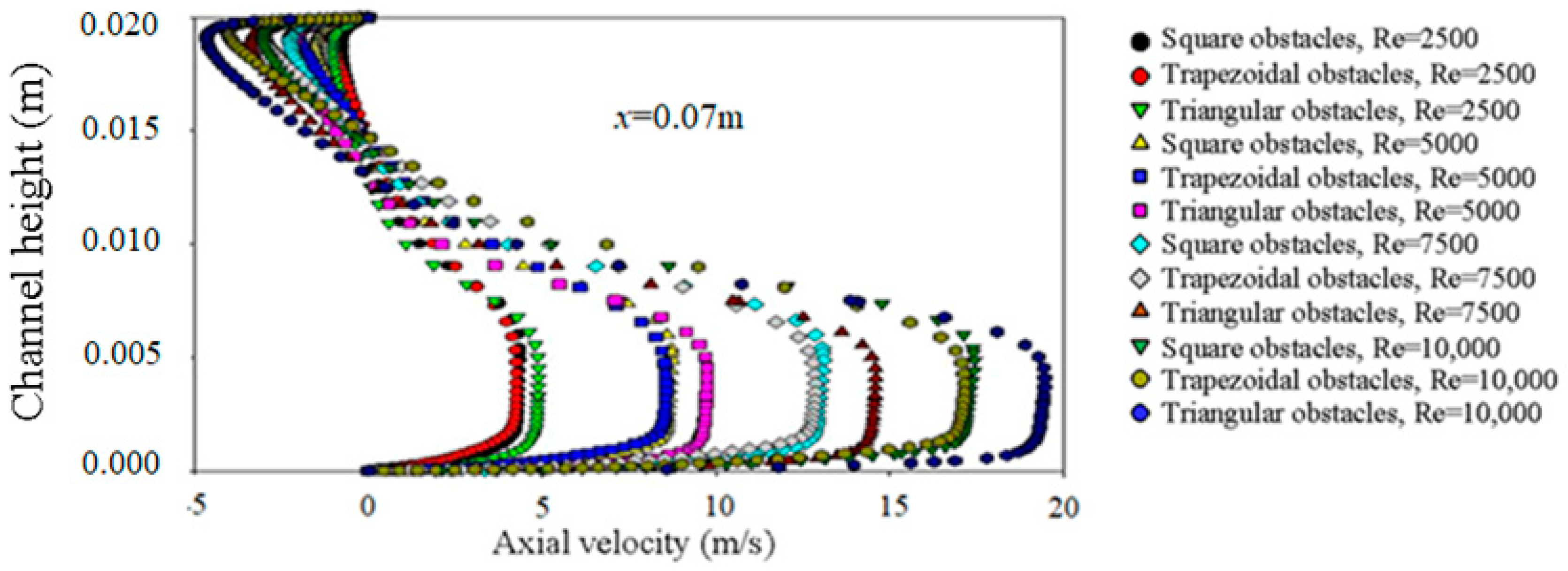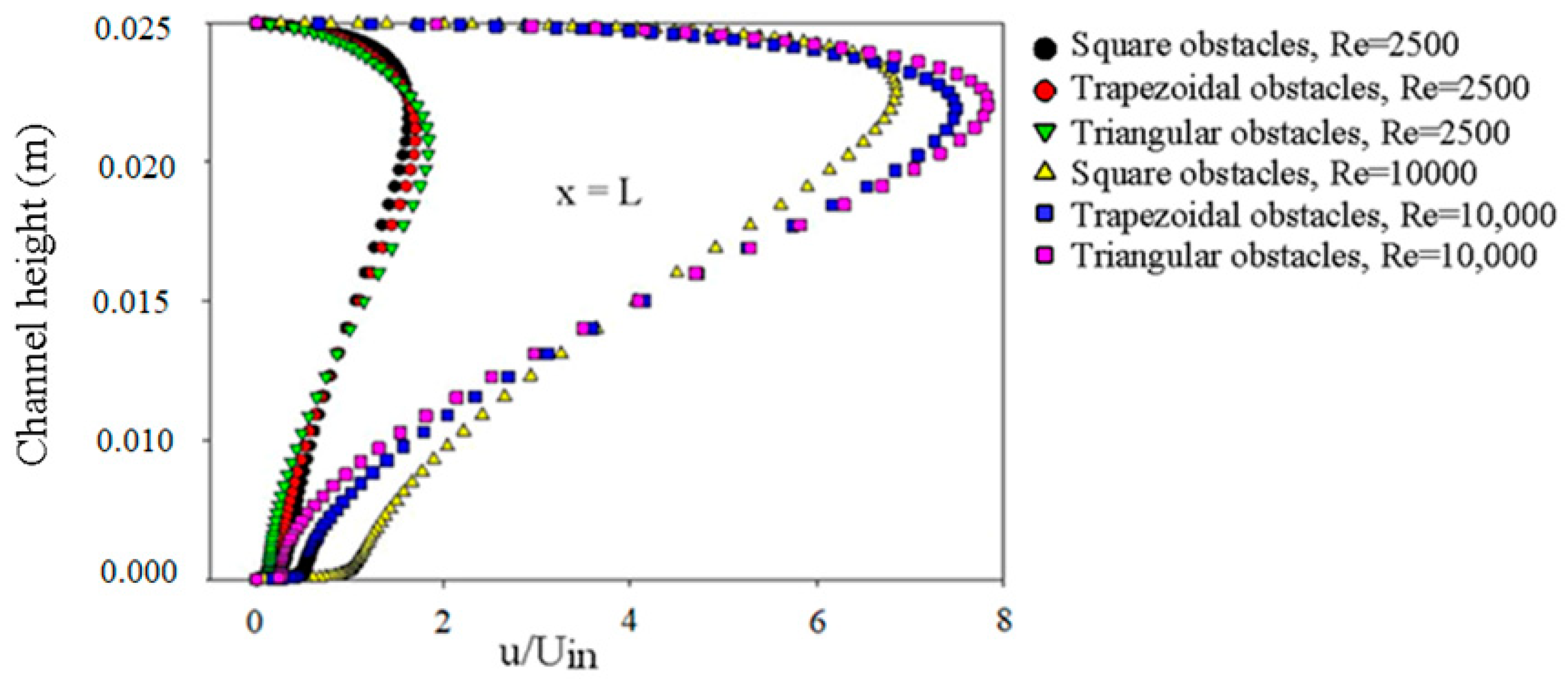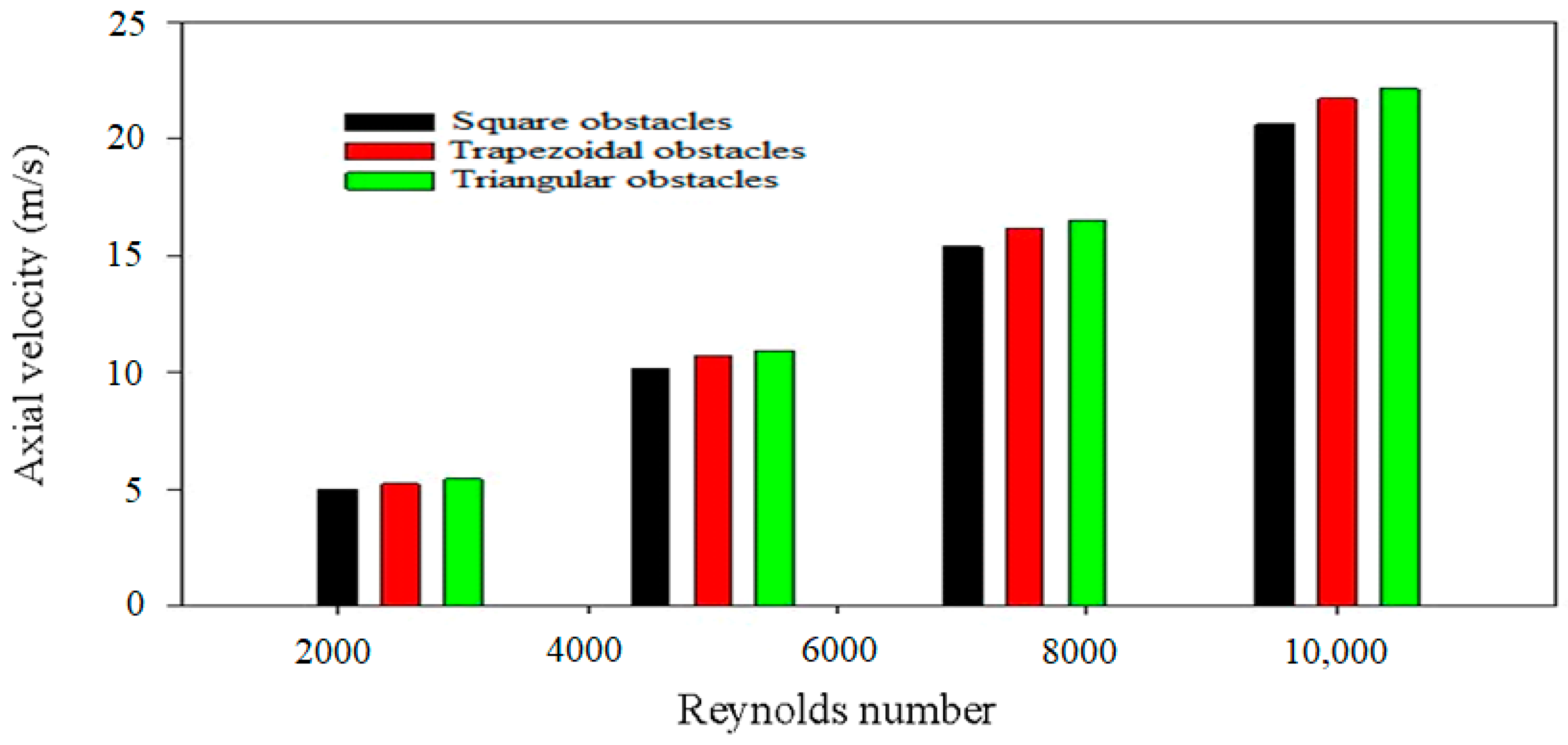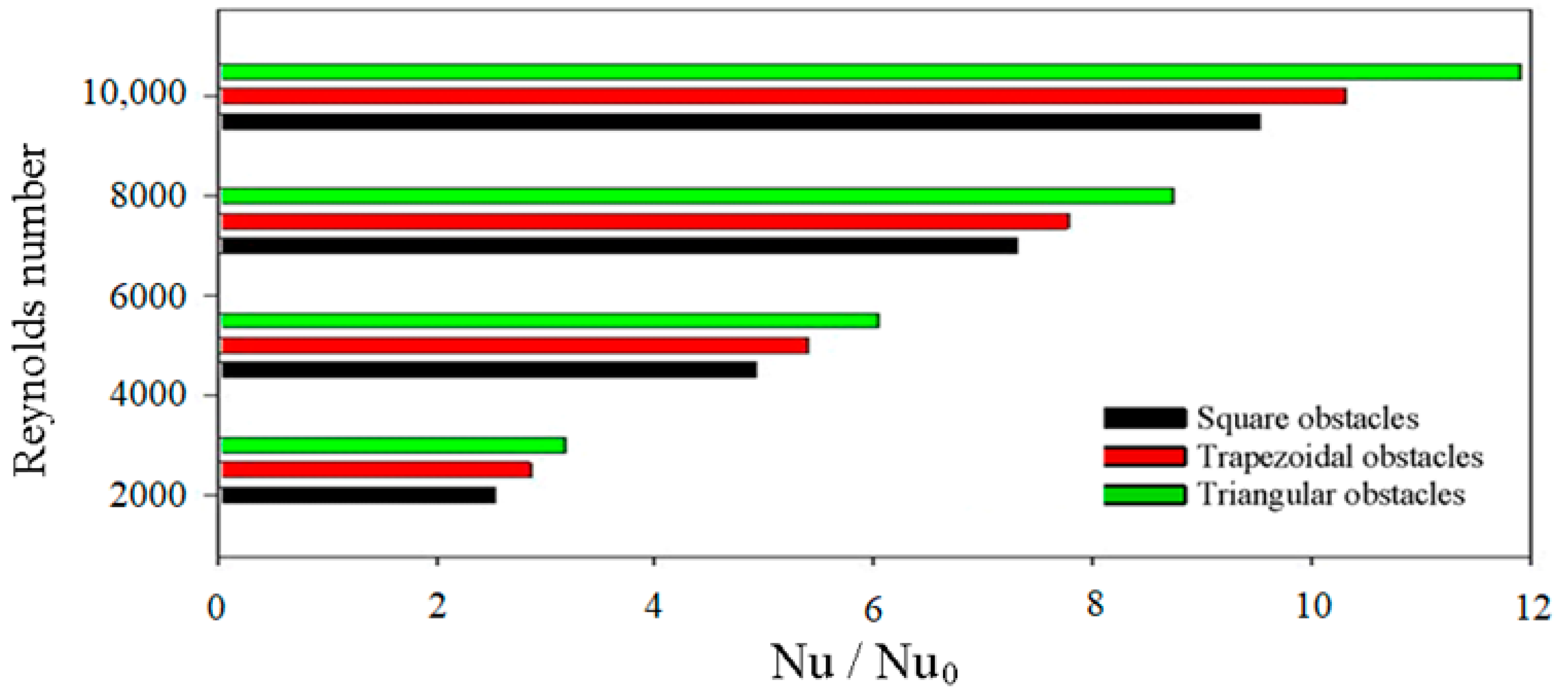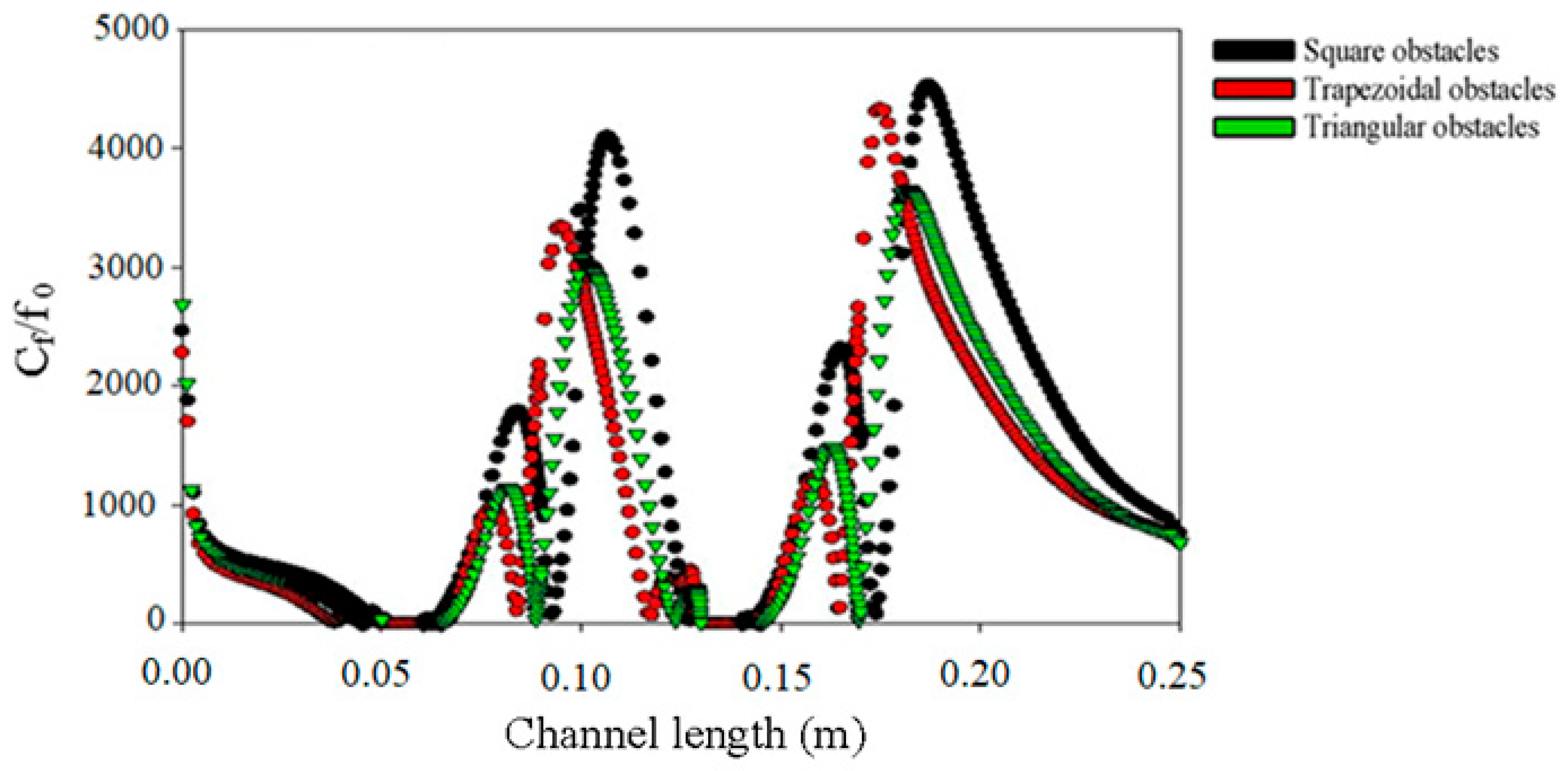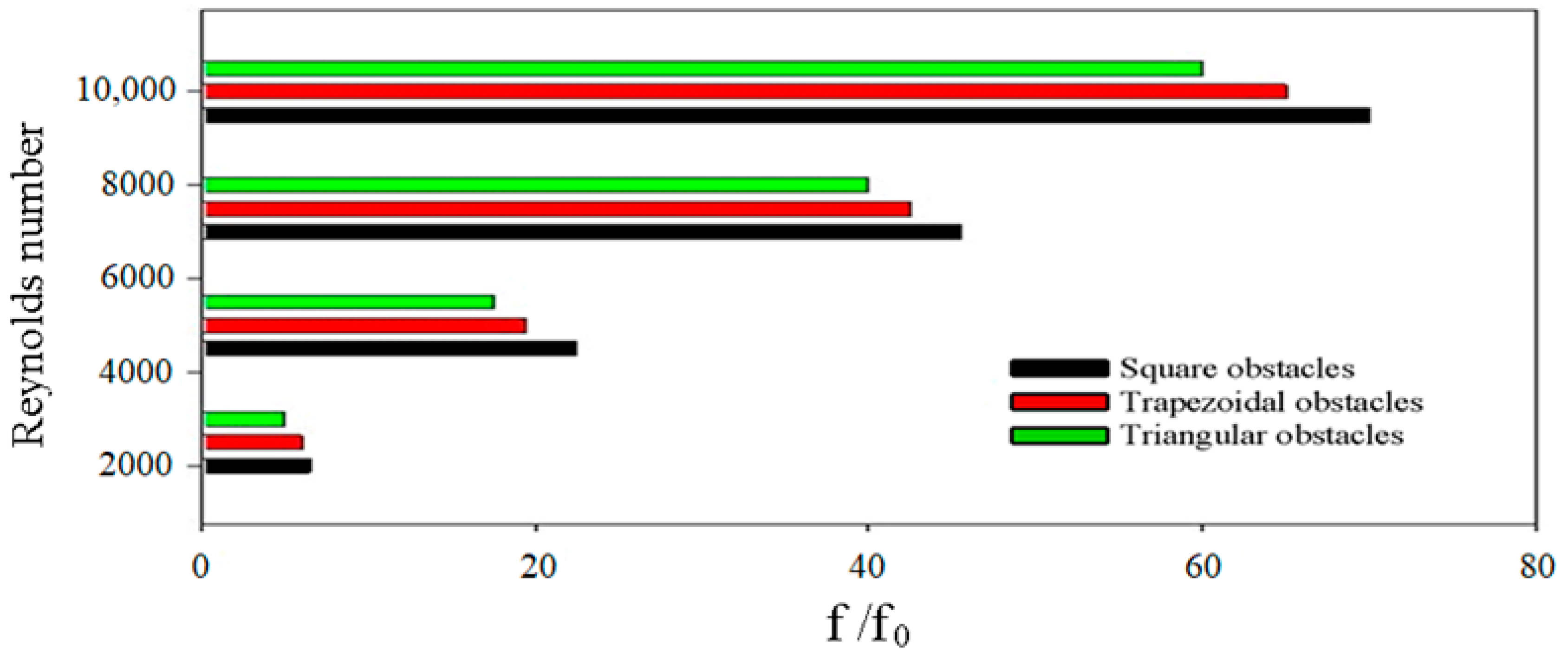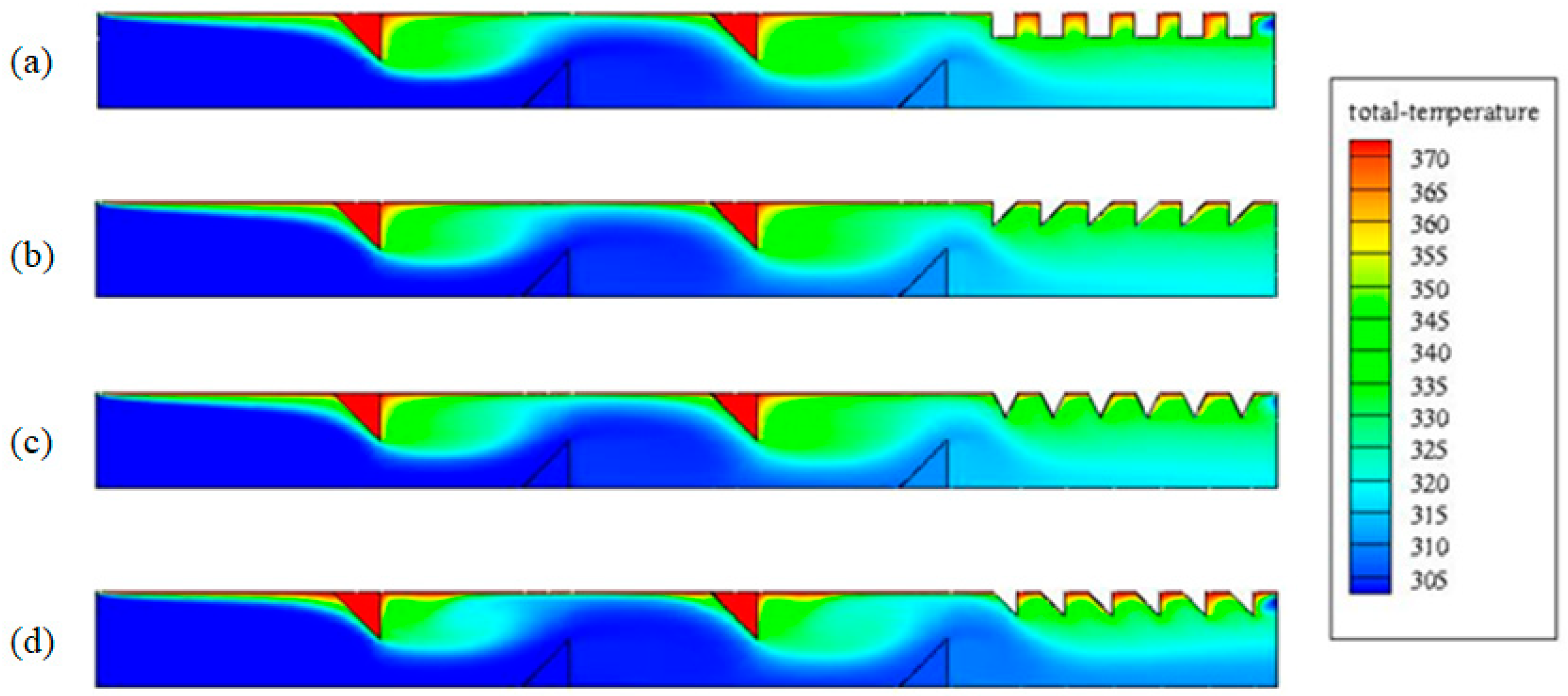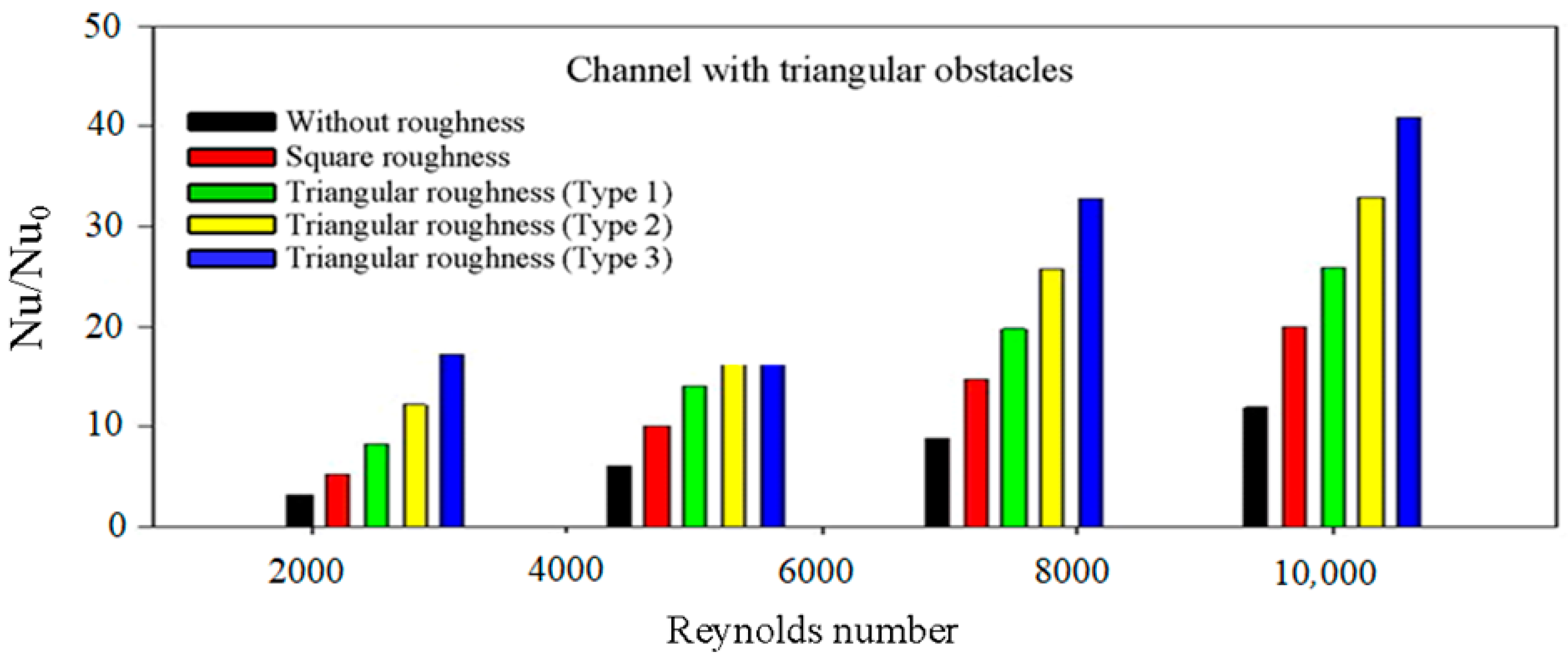1. Introduction
Currently, forced or free convection environments are used to cool personal computers. The most common cooling methods for greater or lower heat flows involve fans attached to the central processing unit. However, due to a number of factors, including the size of the workspace, the noise, and the quality of the limit cooling, these cooling systems have some limitations for electronic components that operate at higher frequencies (over 1000 megahertz). As a result, novel cooling techniques must be used to dissipate thermal energy greater than 100 W/cm
2 from an electronic component’s surface while keeping the device (or component) at acceptable temperatures, usually below 85 °C. In order to accelerate the rate of heat transmission, impediments are placed in the channel’s duct to induce turbulence. Baffles and fins are positioned in the forced flow to create secondary currents or recirculation zones in order to produce turbulence. These are employed to enhance heat transfer in a number of engineering applications, such as solar channels and heat exchangers [
1]. The improvement of heat transmission and pressure drop caused by connecting barrier elements of various shapes, sizes, inclinations, and orientations to the channel walls has been investigated by several researchers [
2,
3,
4,
5,
6] using experimental approaches. Their findings demonstrate that the Nusselt number and thermal efficiency were raised by experimental and numerical analyses to improve thermal performance. The characterization of the air pressure and velocity field inside a rectangular duct with two baffle plates installed on opposing sides was provided by Demartini et al. [
7]. Baffle plates are found in shell and tube heat exchangers, and the geometry of the problem is a simplification of that geometry. The extent of the low-pressure regions in the downstream regions and the high-pressure regions generated upstream of both baffle plates are the most significant aspects seen. Cao et al. [
8] and Saedodin et al. [
9] used the lattice Boltzmann method and Abchouyeh et al. [
10] carried out a numerical investigation of a horizontal sinusoidal baffle channel containing a water/Cu nanofluid. They claimed that when the nanoparticle fraction and obstacle space increased, so did the average Nusselt number values. According to the findings, the wedge ribs significantly improved heat transfer and pressure drop. Chompookham et al. [
11] offer two types of triangular ribs. Using inclined solid and perforated baffles with a Reynolds number of 12,000 to 41,000, two equally sized baffles were introduced into a rectangular channel by Dutta and Hossain [
12], increasing the local heat transfer characteristics as well as the friction through the channel. The findings show that the local Nusselt number has a considerable impact on the orientation, location, and shape of the second deflector. A flat plate solar air heater’s energy and exergy analyses were shown by Kalaiarasi et al. [
13]. In order to increase thermal efficiency, Peng et al. [
14] demonstrated a new kind of solar air collector that uses finned pins on its absorber. Selimefendigil et al. [
15] performed a computational analysis of the hydrothermal properties of the convective laminar nanofluid Fe
3O
4 through a bifurcating type channel with a changeable magnetic field based on the finite element method in addition to experimental methods. Through a square pipe with various baffles, including trapezoidal, triangular, and square shapes, Kamali and Binesh [
16] explored turbulent heat transmission and examined friction properties. A baffle was inserted by Nasiruddin et al. [
17] to enhance heat transfer inside a circular tube. The effect of the baffles’ size and position on the channel’s thermal performance was investigated. Pin fins were installed by Wang et al. [
18] to enhance heat transfer in a rectangular channel. The properties of forced convection heat transfer in the presence of transverse grooves on the bottom surface of a two-dimensional channel were reported by Eiamsa-ard and Promvonge [
19]. With the use of circular section rings with various spacings, Ozceyhan et al.’s [
20] simulation of heat transmission and friction in a tube was accomplished. FLUENT was used to run the simulation, and the Reynolds values ranged from 4475 to 43,725. In a square channel with discrete type “V” baffles, Promvonge et al. [
21] simulate a turbulent flow and heat transfer in three dimensions. This simulation made use of the finite volume approach and the SIMPLE algorithm. In a two-dimensional channel, the effects of introducing diamond-shaped baffles with various tip angles on thermal enhancement were examined statistically by Sripattanapipat and Promvonge [
22]. Yang [
23] reviewed the development of LES applications in transitional flows and gas turbine combustor flows. There were several major challenges/issues associated with LES and its application such as SGS modeling, generation methods for inflow boundary conditions, wall layer modeling, LES of turbulent combustion, etc. He concluded that the LES will be undoubtedly the main tool for engineering fluid analysis within a couple of decades since DNS will still be far too expensive. In the future, LES is likely to be used for a broader range of flow problems and for more complex problems including more multi-disciplinary applications. De Vanna et al. [
24] studied the physical reliability of turbulence modeling in an adverse pressure gradient wall flow setup at moderate/high Reynolds number. A canonical configuration of shockwave/boundary layer interaction is used to illustrate the wall modeling behavior. In particular, a standard equilibrium-based wall-modeling approach, combined with an innovative strategy to keep the no-slip velocity and adiabatic/isothermal temperature constraints at the wall, is adopted. The lattice Boltzmann method was used by Pirouz et al. [
25] to model conjugate heat flow inside a rectangular channel with associated barriers. Mohammedi et al. [
26] investigated how to increase heat transfer efficiency and outlet air temperature in a finned and baffled solar water heater. The enhancement of heat transfer inside a square duct fitted with oblique horseshoe baffles was explored by Skullong et al. [
27]. When airflow and an absorber installed with corrugated fins were present, Priyam and Chand [
28] investigated the effect of flow on the efficiency of a solar collector. To assess the internal flow and heat transfer properties of a solar air collector with baffles, Hu et al. [
29] used numerical analysis. Amraoui and Aliane [
30] used the CFD technique to simulate the research of fluid flow and heat transfer in a solar channel with obstacles, while Amraoui [
31] used CFX software to simulate the study of air flow around a circular obstacle field in an air CSP. The same author, Amraoui [
32], conducted a three-dimensional evaluation of two different solar collector types more recently. To complete their research quickly and cheaply, they used the ANSYS simulation code. In order to improve efficiency, Amraoui and Benosman [
33] incorporated square barriers. The height and pitch of the roughness element are the two most significant characteristics, although many other factors contribute to the arrangement and shape of the roughness components. Reynolds number, rib cross section, angle of attack, and combined turbulence promoters are further parameters. Using direct numerical simulations, Leonardi et al. [
34] investigated the ordered motion of a turbulent flow in a channel with a series of square bars on the lower and upper sides. For the examination of heat transfer in a rough-walled conduit with sand grains and two-dimensional periodic square section ribs on a wall surface for turbulent flow, Miyake et al. [
35] performed direct numerical simulations. The impact of repeated ribs on the thermal efficiency of a flat absorber plate solar air channel was investigated by Ansari and Bazargan [
36]. After designing a ribbed rough surface for a channel, Kim and Kim [
37] presented a study on the numerical optimization technique combined with RANS analysis of flow and heat transmission. A two-passage square channel with and without square section parallel ribs at a 90° angle on a wall surface was subjected to a 3D numerical simulation by Jang et al. [
38]. With angular ribs extruded on two opposing surfaces, Kim and Kim [
39] carried out a numerical simulation of fluid flow and heat transfer for channel shape optimization. In a triangular duct with ribs, Kumar et al. [
40] looked into the flow and heat transmission characteristics. In the context of surface roughness effects, Ryu et al. [
41] looked into the heat transfer characteristics of turbulent flow in channels with two-dimensional ribs and three-dimensional blocks. In order to analyze the heat transfer and hydraulic behavior of the fluid in a rectangular channel flow with periodic ribs installed on one of the major walls, Liu et al. [
42] conducted a numerical and experimental investigation. To forecast the thermal–hydraulic performance of a solar air channel roughened with conical and spherical ribs, Alam and Kim [
43] used numerical simulations. For the numerical optimization of the energy and exergy efficiency of a solar air channel with twisted rib roughness on a heating plate, Kumar and Layek [
44] conducted a stochastic analysis. Skullong et al. [
45] used corrugated grooves embedded with pairs of trapezoidal fins (ATs) positioned on the absorber plate to investigate the heat transfer properties in a solar air channel. In order to explore the heat transfer, friction factor, and thermal–hydraulic performance characteristics of flow in a rough rectangular duct, Deo et al. [
46] carried out an experimental investigation. The thermal and hydraulic performance of a roughened, dual-flow solar air channel with several C-shaped ribs was experimentally investigated by Gabhane and Kanase-Patil [
47]. An experimental investigation on heat transmission and coefficient of friction for a synthetically rough solar air duct was presented by Kumar et al. [
48]. For the range of tested roughness parameters, it was discovered that a rough solar air duct performs better than a smooth duct. The experimental research of heat transmission and friction factor in a countercurrent double-pass solar air channel with a V-shaped discrete rib roughness and shifted over two substantial surfaces of the heated plate was reviewed by Ravi and Saini [
49].
The numerical analysis of the turbulent air flow in forced convection around a barrier was of particular interest to us in this work. In order to validate this model, the outcomes were compared to those reported in the literature under similar circumstances. Our project used fluid calculation code to mimic the cooling of a microprocessor in two dimensions.
2. Methodology
The investigation revolved around a heat exchanger. It has a horizontal, rectangular channel, an isothermal upper wall, a thermally insulated lower wall, and extended surfaces in the form of intermittently spaced-apart obstacles.
Figure 1 presents a precise geometric illustration.
In order to determine the ideal setting for enhanced heat transfer, we primarily concentrated on an essential geometric variable associated with an obstacle in the first section of this study, namely the effect of the slope of their leading edges.
Figure 2 shows three cases that can occur depending on the leading edge of the obstacle’s angle of inclination:
Square obstacles in the case where: ;
Trapezoidal obstacles in the case where: ;
Triangular obstacles in the case where: .
Figure 2.
Different angles of inclination of the straight sides of obstacles: (a) : square obstacle, (b) : trapezoidal obstacle, and (c) : triangular obstacle.
Figure 2.
Different angles of inclination of the straight sides of obstacles: (a) : square obstacle, (b) : trapezoidal obstacle, and (c) : triangular obstacle.
To improve the performance of the heat exchanger channel, rough walls were used in the presence of fins and triangular baffles. The third model,
Figure 2c is compared to the performances of four channels in the presence of four roughness modes: square,
Figure 3a, triangular Type 1,
Figure 3b, triangular Type 2,
Figure 3c, and triangular Type 3,
Figure 3d. In all the cases proposed, the roughness is present only on the upper hot wall of the channel, exactly in line with the last obstacle.
The specific parameters of the geometry and the thermo-physical data of the fluid (air) and of the solid (walls) are indicated in
Table 1 and
Table 2.
The aerodynamic and thermal boundary conditions were chosen according to the simulation of Nasiruddin and Kamran Siddiqui [
17] as shown in
Figure 1.
At the inlet
:
At the outlet
:
where
.
At the upper surface
:
At the lower surface
:
At the solid/fluid interface, the following condition is applied:
where
is the vector normal to the considered surface interface,
and
are thermal conductivities of solid and fluid, respectively.
The computational domain fitted with square obstacle, trapezoidal obstacle, and triangular obstacle was simulated using the computational fluid dynamics (CFD) commercial software ANSYS Fluent.
The
turbulence was adopted in this study. In Cartesian coordinates, the continuity, momentum, energy, and turbulence equations can be written in the following compact form Patankar [
50]:
where
is a variable that serves to represent quantities such as the velocity components
and
, the turbulent kinetic energy
or the rate of turbulent energy dissipation
, and the temperature
. However, the diffusion coefficient
and the source term
have specific values for the different conservation equations in the case of the standard
turbulence model.
Momentum equation in X-direction
Momentum equation in Y-direction
Conservation of energy in the fluid region
Conservation of energy in the solid region
k-Turbulent kinetic energy equation
ε-Turbulent dissipation rate equation
is the rate of kinetic energy production due to energy transfer from the turbulent mean flow; it is given by:
where
;
;
;
;
,
are the constants of the model, as proposed by Laundry and Spalding [
50].
3. Results and Discussion
For the numerical simulations presented in this article, we refer to the experimental work of Demartini et al. [
7], who studied planar baffles.
Figure 4 shows our result and those obtained by Demartini et al. [
7]. The three meshes tested (coarse: 97,593 nodes, medium: 215,897 nodes, and fine: 458,632 nodes) are illustrated in
Figure 4. For turbulence models that use the wall functions equation,
kε, the first cell is placed in the fully turbulent (log-law) region just after the buffer layer which satisfies the condition
y+ ≈ 30. It depicts the pressure coefficient profiles with some previously studied numerical results for
Uin = 7.8 m/s after the second chicane at
x = 0.405 m. A good agreement between the numerical results, for fine mesh, and experimental results is observed, showing the growth of the pressure coefficient near the walls. The lower pressure values near the tip of the baffles are due to the high velocities in this region. Consequently, the fine mesh was chosen, despite the simulation being terminated due to excessive element distortion.
The evolution of the streamlines for the various types of obstacle with angles of
θ = 0°, 0° <
θ < 45°, and
θ = 45° is shown in
Figure 5. According to the obstacle, we see that the streamlines alternate between the three forms,
Figure 5a–c. The streamlines in
Figure 5a (square obstacle) are less contoured as they cross the barrier, causing turbulence that disrupts the flow. The streamlines in
Figure 5b, for the trapezoidal obstacle, straighten as they cross it, changing the streamlines’ field direction. The streamlines are attached to the obstacle in
Figure 5c, the triangular obstacle, giving us a powerful streamline field.
According to
Figure 5, complex phenomena including recirculation zones and regions of turbulence upstream and downstream of the obstacle are produced by the flows in the air veins for the three different types of obstacle. The existence of impediments leads the three air streams to divide into multiple distinct zones above, below, and upstream of the obstructions. As a result, the flow creates recirculation zones (Zone A) close to the lower obstacles, which intensifies the turbulence upstream of the upper obstacles (Zone B). In addition to the separation of the fluid flow induced by the obstructions (Zone C), there are dead zones upstream of the lower obstacles (Zone C) plus the separation of the fluid flow caused by the obstacles. We observe that the importance of the dead zone for trapezoidal-shaped obstacles is less than that of square obstacles, and that it is almost zero for the model with triangular obstacles. When compared to previous models that have square and trapezoidal barriers, the model with triangle obstacles has a significantly large turbulent zone (Zone B).
Figure 6 depicts dynamic pressure, which is the flow of momentum per unit volume (the kinetic energy density). The three varieties under study are similar in terms of the overall dynamic pressure setup.
The dynamic pressure is uniform at the entrance, immediately below the first upper obstacle zone. Upstream of the upper and lower obstacles, the dynamic pressure approaches zero values. The zones (A, B, C, and D) with the highest dynamic pressure are separated by the sharp upstream edge. However, the flow separates from the obstacle’s wall, which results in a depression downwind of these obstacles. Due to the poor circulation at this location, the dynamic pressure at the attack terminals in
Figure 6a is nearly negligible. The dynamic pressure in
Figure 6b must be displaced along the profile, causing an average flow of kinetic energy. The pressure in
Figure 6c has a substantial value since the profile is ideal, which allowed for a large movement.
For the three types of obstacles, 0° <
θ < 45°,
Figure 7 shows the dynamic pressure fluctuation as a function of the Reynolds number (
Re = 2500, 5000, 7500, and 10,000). Remember that pressure increases every time the Reynolds number increases. As can be seen, the pressure values for the square and trapezoidal obstacles are extremely close to each other. In addition, compared to the two preceding situations, the pressure value in the triangular case is relatively low.
The entire distance traveled over a certain period of time divided by that period of time is the average velocity. The vortex is always created upstream of the rectangular obstacle, as seen in
Figure 8. On the other hand, at the level of the triangular and trapezoidal obstacles, the flow consistently adheres to the obstacle’s wall and follows it. As a result, the flow has two crucial moments. Figures clearly demonstrate that the ridge downstream of the obstacle has an impact on fluid behavior even upstream of it, altering how the flow interacts with the upper wall of the triangle obstacle. This enables us to claim that the presence of the inclination at the level of the edge upstream of the obstacle not only controls the zone of the triangle but also the area around this obstacle.
According to the average intensity of the velocity, different zones are identified in the three models under investigation (low or high). Just upstream of the first obstacle, the average velocities for the three models under study are low. Along the downstream side of square, trapezoidal, and triangular obstacles, they are also weak. For the three models under study, the average velocities are very high under both the upper and lower obstacle.
The distribution of the average velocity as a function of the Reynolds number is shown in
Figure 9. Keep in mind that the average velocity increases as the Reynolds number increases. Additionally, we discover that for Reynolds values 2000–6000, the average velocity in the three instances was quite similar. Reynolds number 6000 indicates that the average velocity dropped in the case of the triangular obstacle and stayed constant in the situations of the square and trapezoidal obstacles.
For the square, trapezoidal, and triangular examples under study, the fluctuation of the axial velocity is depicted in
Figure 10. As a result of the obstacle, it can be seen that the flow is actually accelerated. For the flow’s perfect straightening upstream of a triangular obstacle, axial velocity is crucial. Velocity is affected in the case of the trapezoidal obstacle. However, because of the vortex that is created in the square case, the velocity varies.
At
x = 0.07 m and for various values of the Reynolds number in each of the cases taken into consideration,
Figure 11 shows the fluctuation of the axial velocity as a function of the height of the channel. When the channel height is between 0 and 0.015 m, it is shown that the velocity increases, and that the velocity increases as the value of the Reynolds number increases. If we use a Reynolds number to examine the axial velocity profiles for the three models, we find that the square and trapezoidal obstacle models have nearly identical velocities.
For the model with triangle obstacles, the velocities take substantial values. The velocities are observed to be in the opposite direction of the flow at a height of 0.015 m, and the model with triangular obstacles has the highest values of velocities when compared to the other models (
Figure 12).
The profiles of the ratios
at the channel’s outflow (
x =
L) are shown in
Figure 13. These profiles demonstrate that for the smallest Reynolds number,
Re = 2500, the ratios
are similar. The ratios
(at the point 0 up to 0.01 m) of the model with a triangular obstacle are low for the maximum Reynolds number,
Re = 10,000. For the square obstacle, the model has high ratios
. The model with a triangular obstacle has large ratios
at positions 0.01 to 0.018 m.
For the square obstacle, the model has low ratios . The other heights for the three models range from 0.018 to 0.02 m. The fluid is viscous, thus when close to the wall, the velocity is zero. Due to the constant section and the varied flow, the various Reynolds numbers result in a variation in velocity.
The change in average axial velocity for the three examples is shown in
Figure 14 as a function of Reynolds number. As can be seen, the axial velocity increases as the Reynolds number increases. However, the three investigations revealed an increase in axial velocity. When the Reynolds number is between 2000 and 4000, the velocity value is roughly constant at 5 m/s.
From the value of the Reynolds number 4000, it can be seen that the three examples have different velocities, with the triangular obstacle having the smallest increase in velocity, followed by the trapezoidal obstacle, and then the square obstacle.
Figure 15 shows how the vertical (transverse) velocity varies in the three cases of the triangle, trapezoid, and square. With the exception of the head of the obstacles, the transverse velocity is homogeneous throughout the duct of the channel. However, at the left extremities of the upper and lower obstacles, the velocity assumes positive and negative values, respectively. Upstream of a square obstacle, the velocity is high because of the abrupt pipe section reduction.
The straightening of the flow causes a trapezoidal obstacle to reduce velocity. Due to the consistent convergence of the channel segment in the event of a triangular obstacle, the velocity is low.
For various shapes of obstacles,
Figure 16 illustrates how the maximum transverse velocity varies as a function of the Reynolds number. The velocity rises as the Reynolds number rises. Due to the acute deformation of the pipe section, which results in a vertical translation of the fluid particles, the square shape has the fastest velocity. Due to the low flow convergence, the trapezoidal form moves slower than the square impediment. Compared to other obstacle forms, the triangle shape moves at a slower speed, which reduces the vertical component of velocity by half.
The temperature field is depicted in
Figure 17. Forced convection causes the air near the absorber to heat up quickly the secondary air in the lower part of the channel downstream of the upper obstacles in Zone A; this suggests that the temperature is high for the three models under consideration. It has been shown that the square obstacle’s weak flow recirculation results in minimal contact between the cold air and the obstacle. Due to the obstacle’s diversion of the flow in the trapezoidal cases, we see that there is good turbulence. We obtain good cooling in the triangular instance because the interaction between the cold air and the impediment is significant downstream of the obstacle.
The temperature change at the channel’s exit is shown in
Figure 18 for a range of Reynolds number values and obstacle types. With increasing pipe height, the fluid temperature profile rises exponentially with a different curve for each value of the Reynolds number. Due to the substantial heat flux that heats the surface, the triangle obstacle has the maximum heat transfer. The temperature value at the middle of two configurations is what causes the trapezoidal obstacle to have an average heat flow (between square and triangular). Due to the cooling air temperature, the square obstacle has the weakest heat transmission (poor cooling). It can be concluded that the temperature values of the model channel with triangle obstacles are very high. The three models’ temperatures are comparable when the Reynolds number is raised to 10,000.
Figure 19 shows how the square, trapezoidal, and triangular shapes of obstacles affect the evolution of the adimensional Nusselt ratio
with channel length. Depending on the width of the channel, the Nusselt number fluctuates sinusoidally between obstacles.
The turbulence of the flow results in increased convective heat transfer, which is illustrated in the picture as having a significant value for the Nusselt number in the case of the triangle obstacle. As the heat flow is blended in the trapezoidal enclosure, the heat transfer is better (a solid part and a fluid part). As there is more heat transfer in the solid in the square example, the Nusselt number is low, emphasizing the significance of conduction. The important values in the model with triangle obstacles are used to calculate the normalized local Nusselt number; the value of the ratio reaches a maximum of 1600 at the 0.17 m position. This explains why the model with triangle obstacles had better heat transfer than the other models analyzed.
The change in the average normalized Nusselt number
as a function of the Reynolds number for various obstacle forms is shown in
Figure 20. It has been noted that as the Reynolds number rises, the average Nusselt value also rises (convection is important for a high Reynolds value, and conduction is almost zero for high velocities). The high axial velocity produces a higher convection force than the other examples, by increasing the fluid’s recirculation zones, as shown in the picture, which demonstrates that the Nusselt number has a considerable value in the case of the triangle obstruction. The Nusselt number is smaller for the trapezoidal obstacle because the shape itself creates the restriction to the flow. Due to the geometry of the impediment blocking flow velocity in the square case, the Nusselt number is low.
Over the course of the channel’s whole hot length,
Figure 21 depicts the local variation of the friction coefficient’s adimensional ratio
. Only at the level of the obstacles does the coefficient of friction rise. The figure demonstrates that for the square obstacle, the friction coefficient has a high value. At a distance of 0.19 m, the value of
can be as high as 4800. The average value of the coefficient of friction is zero due to the flow’s straightening. As the air flow is homogeneous in the triangular example, the coefficient of friction is low.
This shows how the physical characteristics of the fluid flow, the increase in heat transfer rate resulting from the decrease in the local coefficient of friction, are strongly influenced by the geometry of the obstacles.
Figure 22 illustrates the evolution of the friction ratio
according to the different values of the Reynolds number for different obstacle models. On the other hand, it is seen that for the three models examined, the average coefficient of friction rises as the Reynolds number rises. When comparing the models for a given Reynolds number, we see that the average coefficient of friction values for the model with square obstacles are crucial due to the significant turbulence they produce. However, because of air recirculation, the average coefficient of friction values for the model with triangular obstacles are low.
To enhance heat transmission between the absorber and the heat transfer fluid, the researched roughnesses of square and triangular Type 1, Type 2, and Type 3 are situated on the hot top part of the channel (absorber), downstream of the second baffle. In the presence of triangular obstacles,
Figure 23 shows the distribution of the average velocity as a function of the shape of the roughness (square roughness and triangle roughness). Due to the driving surface’s unprofiled deformation, the average velocity in the case of square roughness is insignificant. As the subsequent profile lies downstream of the triangular roughness (Type 1), the average speed is low at the beginning of the roughness. Due to the flow profiling discontinuities with the triangular roughness (Type 2), the average velocity is relatively high. The average velocity has a significant value when there is triangular roughness (Type 3).
Figure 24 displays the temperature distribution for each of the four proposed models for the roughness, fin presence, and triangle baffles across the entire examined region. The temperature is quite high where the absorber and obstacles are located, as well as in the roughness asperities. The channel’s exit is improved by the addition of roughness. Due to inadequate air recirculation at the roughness’s center, the fluid temperature field has low cooling effectiveness in the case of square roughness. Due to the airflow being inserted into the triangle roughness Type 1, the channel has effective cooling. Due to the good curvature of the triangle roughness Type 2, the temperature field has good agitation in the region. Due to the best heat flow straightening provided by triangle roughness Type 3, the temperature field has ideal cooling in this scenario.
For each of the several situations of roughness considered for the air duct with triangular fins,
Figure 25 shows the fluctuations in values of normalized average Nusselt number
as a function of the Reynolds number. With an increase in Reynolds number comes an increase in the mean Nusselt number, and high velocity produces high convection.
Due to the flow’s effective guidance, the figure demonstrates that the average Nusselt number is large in the case of triangular roughness Type 3. Due to the regular separation of the flow, the Nusselt number is decreased in the case of triangular roughness Type 2.
Because the attack surface has straight roughness in the case of triangular roughness Type 1, the Nusselt number is low. Due to inadequate fluid recirculation, the Nusselt number in the case of square roughness is minimal. The exchange surface is low in the absence of roughness, which causes a very noticeable fall in the Nusselt values.
For four various types of roughness, including square and triangular roughness,
Figure 26 depicts the evolution of the average ratio
as a function of the Reynolds number, which ranges between 2500 and 10,000 (Types 1, 2, and 3). As Reynolds number rises, the average coefficient of friction rises as well. As there is a huge contact surface in the case of square roughness, the figure demonstrates that the average coefficient of friction has a high value. Moreover, as the triangular roughness Type 1 is perpendicular to the flow direction, the coefficient of friction is lower. Due to the minimal flow disturbance in the case of a triangular roughness Type 2, the coefficient of friction is lower. The low flow resistance in the case of a triangular roughness Type 3 lowers the coefficient of friction. When there is no roughness, the coefficient of friction is low because the flow cannot be impeded.


